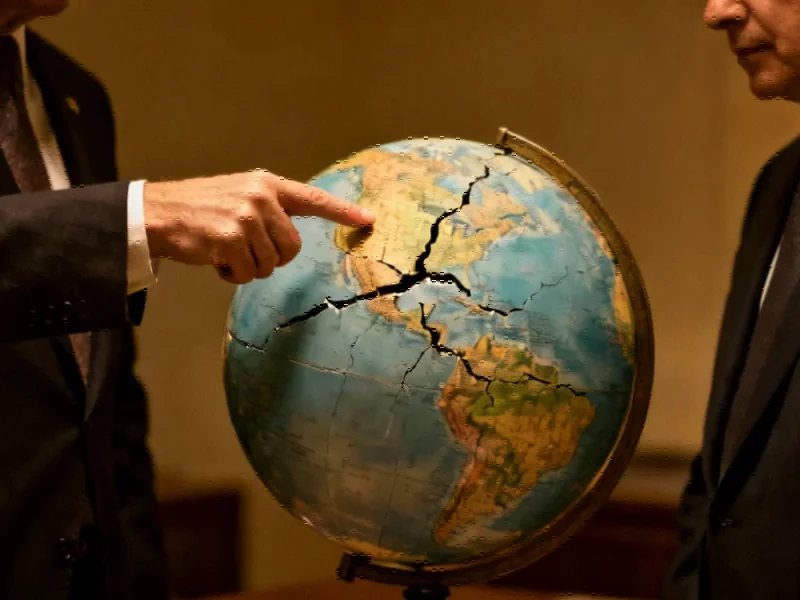The Diplomatic Disconnect
As US-China trade negotiations continue to stall, observers are noticing a troubling pattern reminiscent of dysfunctional relationships. The current impasse between the world’s two largest economies reveals deeper structural issues in their diplomatic engagement. Unlike previous administrations where established channels facilitated dialogue, the current communication landscape appears fragmented and unreliable.
The Lost Art of Backchannel Diplomacy
During President Trump’s first term, the so-called “Kushner channel” provided a crucial line of communication between Washington and Beijing. Jared Kushner’s relationship with then-Ambassador Cui Tiankai helped navigate complex negotiations and ultimately paved the way for the 2020 phase one trade deal. Today, that channel has evaporated, leaving official talks between Treasury Secretary Scott Bessent and Chinese Vice Premier He Lifeng deadlocked after multiple rounds of fruitless discussions.
The current negotiators, while competent in their respective domains, lack the nuanced understanding of each other’s systems that characterized previous diplomatic engagements. This communication vacuum comes at a critical time when trade negotiations remain stalled amid communication breakdowns that threaten global economic stability.
The Corporate Intermediary Dilemma
In the absence of formal diplomatic channels, both nations have explored unconventional intermediaries. High-profile business leaders including Elon Musk, Jensen Huang, and Stephen Schwarzman have been floated as potential go-betweens. While these figures can occasionally facilitate message-passing, none possess the consistent access and trust required for comprehensive negotiations covering sensitive topics like Taiwan alongside trade issues.
The situation reflects broader industry developments where private sector actors increasingly find themselves navigating complex geopolitical landscapes. However, the limitations of this approach became evident when Nvidia’s Huang faced backlash from Trump supporters after commenting on China policy, demonstrating the political risks of corporate diplomacy.
Structural Barriers to Communication
Multiple structural factors complicate communication efforts. On the American side, the gutting of the National Security Council has depleted institutional China expertise, while internal divisions between security hawks and business interests create contradictory impulses within the administration. Recent market trends suggest that this uncertainty is affecting global investment patterns as businesses seek stability elsewhere.
China’s political environment presents equal challenges. President Xi’s concentration of power and recent purges of Washington-connected diplomats have made Chinese officials increasingly risk-averse. The removal of diplomats like Qin Gang and Liu Jianchao, combined with the retirement of influential figures like Wang Qishan, has substantially narrowed China’s diplomatic flexibility.
Technological Dimensions of the Standoff
The trade dispute increasingly centers on technology competition, particularly in semiconductors and artificial intelligence. The back-and-forth restrictions on chip sales highlight how technological competition has become intertwined with trade negotiations. These developments coincide with significant related innovations in computing and AI that both nations are racing to dominate.
Meanwhile, security concerns have driven both countries to examine their technological infrastructure, including secure communication platforms for sensitive discussions. The inability to establish trusted communication channels mirrors broader challenges in US-China technological decoupling.
Potential Pathways Forward
Despite the grim outlook, limited progress remains possible in discrete areas. The September agreement transferring TikTok to American-controlled ownership demonstrates that focused negotiations can yield results. However, without overhauling communication infrastructure, such achievements will likely remain isolated rather than forming part of a comprehensive framework.
Some experts suggest that the solution may lie in building more robust institutional channels rather than relying on personal relationships. This approach would require developing deeper expertise within government agencies and creating more formal consultation processes. As recent technology sector expansions demonstrate, long-term strategic planning often yields better results than ad-hoc negotiations.
The Leadership Divide
Fundamentally different approaches to diplomacy between Presidents Trump and Xi complicate resolution efforts. Trump’s preference for personal diplomacy and spontaneous deal-making contrasts sharply with Xi’s methodical, procedure-oriented approach. This stylistic mismatch, combined with domestic political constraints on both sides, creates significant barriers to breakthrough agreements.
China’s recent reactivation of retired ambassador Cui Tiankai suggests recognition of the communication problem, but it remains unclear whether such efforts can bridge the fundamental trust deficit. Without more reliable channels, the cycle of temporary truces and sudden escalations seems likely to continue, with significant implications for global economic stability and technological cooperation.
This article aggregates information from publicly available sources. All trademarks and copyrights belong to their respective owners.
Note: Featured image is for illustrative purposes only and does not represent any specific product, service, or entity mentioned in this article.



